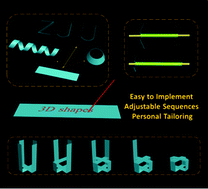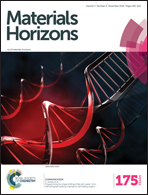A “writing” strategy for shape transition with infinitely adjustable shaping sequences and in situ tunable 3D structures†
Abstract
A light “writing” strategy is developed to generate easy-to-implement, sequential and “personalized tailoring” three-dimensional (3D) shape transition by exploiting the photothermal conversion capability of polydopamine (PDA) and the shape memory effect of Nafion films. A homogeneous Nafion/PDA composite film in a stretched temporary shape and a near infrared (NIR) laser are employed as paper and pen, respectively. With localized heat generated from tunable NIR light irradiation, well controlled internal stress can be “written” into the film precisely and thus trigger complex 2D–3D shape transition instantly. The tunability and predictability of the obtained 3D shapes are verified. Compared with previous methods, such a light “writing” strategy can be used to modulate both the target shape and the shape transition process in situ at the same time with no need to tune the material compositions or structures. Stepwise shape transitions with infinitely adjustable shaping sequences are realized in this work, which is of crucial importance in constructing overlapped structures. Furthermore, the 3D shapes can be adjusted flexibly to meet on site individual requirements. This adaptability makes it a new way to tackle the contradiction between individual variation and standardized manufacturing techniques in fields like personalized healthcare.


 Please wait while we load your content...
Please wait while we load your content...